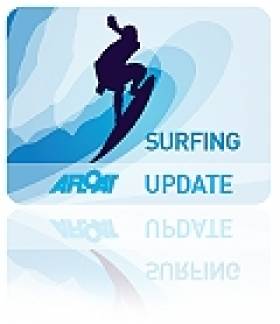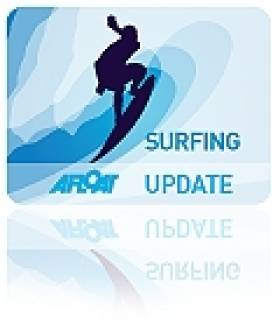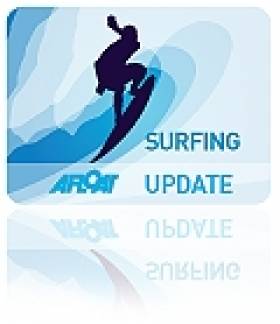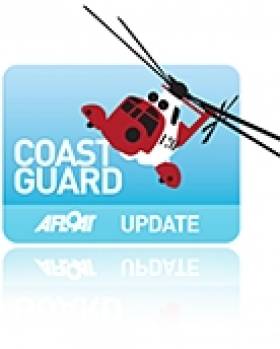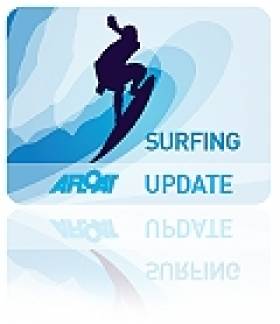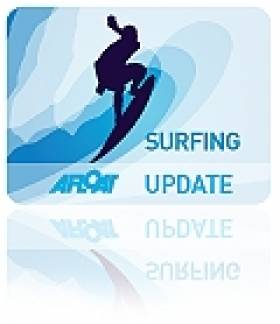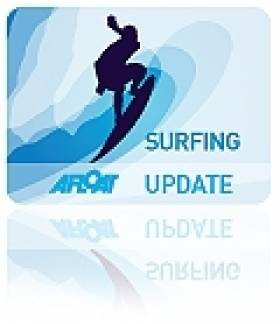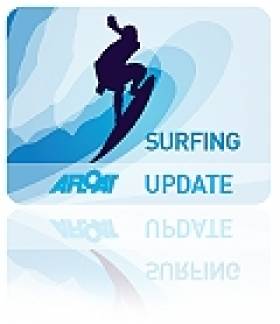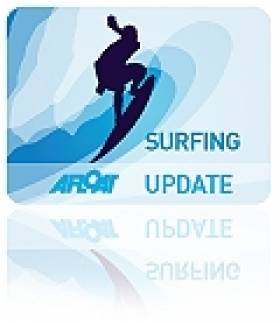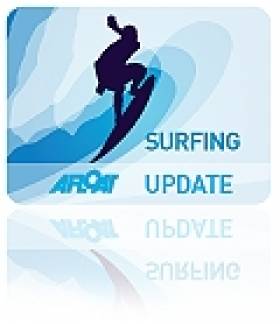Displaying items by tag: Surfing
Cotty Gets Big Wave Nomination For Storm Rachel Giant At Mullaghmore
#Surfing - Mullaghmore regular Andrew 'Cotty' Cotton has secured a nomination in the 2015 Billabong XXL Big Wave Awards for his monster ride on the swells that preceded Storm Rachel this week.
According to The Irish Times, Cotty skipped an appointment with his chiropractor to race from his Devon home to the Sligo coast a week ago to make the most of the strengthening surf.
Shaking off the effects of a shoulder injuring sustained while surfing at the infamous Praia do Norte in Portugal last month, he was ready to take advantage on Monday.
That's when the waves reached their peak in the midst of an "exceptional" five days of surf to match or even better the Vikings storm of 2012.
And luckily for us, it was all caught on video for a new documentary on his and other big wave surfers' adventures on the edge.
The Irish Times has more on the story HERE.
#Surfing - An Irish surfer who went missing off the east coast of Australia last summer underestimated the dangerous conditions, an inquest has heard.
As previously reported on Afloat.ie, Stuart Butler was swept out to sea in a rip current while surfing with friends near Tallow Beach, south of the Gold Coast in New South Wales on 19 July. His body has not been found.
According to ABC News, neither Butler nor his friends were experienced surfers, and the survivors told the inquest that they did not appreciate the dangers till they had already paddled out.
"[Butler] was pretty panicky, had frozen up a bit... was pretty scared to be honest," said Michael Fuller, who himself was found by rescuers on rocks at the base of Cape Byron with minor injuries.
ABC News has more on the story HERE.
Lone Irish Entrant In New World Surf League For 2015
#Surfing - Glenn Hall is the only Irish surfing name set for competition in the 2015 World Surf League, the new name or the ASP World Tour.
Surfer Today has the full rundown of competitors, which includes such luminaries as multiple-time world champion and living legend Kelly Slater, and Irish-Australian surf pro Mick Fanning.
Australians make up the biggest proportion of entrants, with 12 Aussie surfers out of the 34-strong field set to challenge for the 2015 title.
In other surfing news, the ASP World Tour website has some breathtaking images of American big wave surfer Kurt Rist riding the tube of a massive swell that crashed over Mullaghmore Head in early November - his nomination for the 2014 XXL Big Wave Awards.
Surfer Found Safe And Sound In Lahinch Beach Search
#Coastguard - The Clare Herald reports on the happy outcome after a search for a missing surfer near Lahinch yesterday afternoon (Monday 15 December).
Members of the Irish Coast Guard's Doolin unit began combing the beaches of Lahinch after an emergency call from a concerned family member.
But the surfer was quickly locoed safe and well just south of the Co Clare town, a popular surfing hotspot even in winter.
'Weather Bomb' Brings Record-Challenging Big Waves, Top Surfers To Nazaré
#Surfing - This is no computer simulation: it's a very real, very large wall of water being surfed by an actual human off Portugal this past Thursday 11 December.
With a poor wind direction putting paid to any attempts to ride big swells crashing in on Ireland's northwest with the recent 'weather bomb', the world's top big wave surfers - including a number of Mullagmore regulars like Andrew Cotton - turned their attentions to Nazaré, site of 2012's record-breaking monster.
And as Magic Seaweed reports, they weren't disappointed, with former Billabong Big Wave Tow-In champion Eric Rebiere calling Thursday's massive rampart "for sure the largest waves I've seen".
Of course, big waves of this exceptional kind are a regular occurrence at this Portuguese hot spot, as this recent photo gallery from the Guardian demonstrates.
Furious Waves Off Inishowen Peninsula As 'Weather Bomb' Hits Ireland
#Weather - Huge waves came crashing over the Inishowen Peninsula yesterday as the Atlantic 'weather bomb' hit the northwest coast.
The video above, care of The Daily Edge, shows the sheer power of the swells that brought waves as high as 62 feet off Irish shores, putting the cream of the world's big wave surfers on high alert.
But as previously reported on Afloat.ie, the best surfing conditions need more than just a big swell - with the forecast wind direction putting paid to any attempts at riding a monster.
Surfers On Alert As Large Swell, High Winds Sweep In
#Surfing - Big wave surfers on the west coast are at the ready today (9 December) as a strong northwest groundswell bears down on Ireland, bringing with it waves of up to 50 feet across the Atlantic.
According to Surfer Today, the storm heading our way has a particularly wide eye, and a fetch - the area of water over which the winds are blowing - larger than the whole of the United Kingdom.
Indeed, it should bring to mind the infamous 'Black Swell' that swept in with Storm Christine almost a year ago, attracting the cream of Europe's surfing crop to the big wave hotspots of the northwest.
However, Richie Fitzgerald of Bundoran's Surfworld tells the Irish Examiner that the wind direction will put paid to any quality surfing action this week.
For the rest of us, meanwhile, the increasing wind speeds - gusting up to 110km/h off Irish coasts - have prompted Met Éireann to issue a Status Orange weather warning for northwestern counties, as RTÉ News reports.
There will be little escape for the rest of the country, either, with a Status Yellow warning in effect for forecast gusts of over 70km/h till Thursday morning (11 December).
Video Shows Surf Pro Making A Break For It At Mullaghmore
#Surfing - World-class surfing pro Michel Bourez took time out from his busy World Championship Tour schedule to recharge on the wild waves off Mullaghmore Head in Co Sligo.
As regular readers of Afloat.ie will know, Mullaghmore is now firmly established as a mecca for big wave surfers around the world, producing monsters swells to beat the best at the Billabong XXL Big Wave Awards.
The cold water was a big change for the Tahitian who's used to much warmer climes, but he says the experience brought him back into the right headspace to rejoin the tour with renewed confidence.
In other surfing news, JOE.ie brings us remarkable GoPro video of a longboarder in action in the waves off Bundoran.
It's certainly a unique angle on a sport usually watched from the safe distance of dry land.
Tech Meets Sport At Westport's Surf Summit
#Surfing - Surfing pros Andrew Cotton and Anastasia Ashley were among the speakers at the Surf Summit in Westport this weekend, a spinoff of last week's momentous Web Summit.
As The Irish Times reports, the networking event – which even attracted Taoiseach Enda Kenny to the Mayo surf haunt – intended to bring together entrepreneurs, start-ups and investors in a more relaxed atmosphere than the three-day RDS conference.
At the same time, it also highlighted the growing industry around surfing in Ireland, which has exploded on the world surf scene in recent years – with no small thanks to surfers like Cotton putting our big waves on the map.
The Irish Times has more on the story HERE.
Cornwall Surfing Tragedy Reminder Of Sea's Dangers
#Surfing - Winter surfers are reminded to beware of dangerous currents upon news of the tragic deaths of three people off Newquay at the weekend.
RTÉ News reports that the two men and one woman were part of a group of seven who got into difficulty while surfing at Mawgan Porth Beach in the popular Cornish surfing town.
Local surf school owner Peter Abell described conditions on the day as "not as bad as it can be" and "not particularly dangerous" but added that it "wasn't the safest of days to be in the sea".
According to the Guardian, safety measures at the busy surf spot are to be reviewed as it emerged the middle-aged surfers had entered the water at an area where the absence of beach lifeguards is clearly signposted.


























